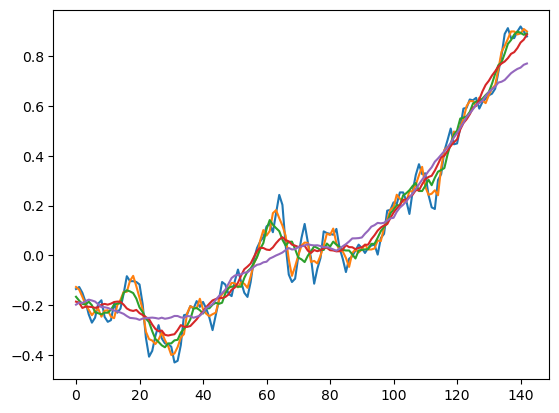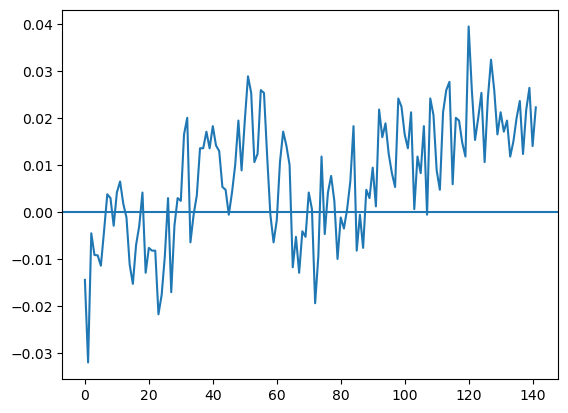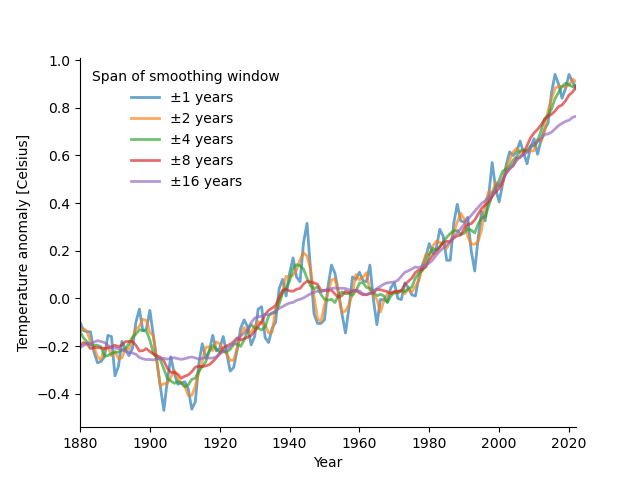Bonus exercises: Temperature anomalies#
# EXECUTE BUT DO NOT CHANGE
import numpy as np
def load_anomalies():
# Load the full anomaly data set
data = np.loadtxt('temperature.csv', skiprows=1, delimiter=',')
years = [int(y) for y in data[:, 0]] # unpack the table and cast years to int
temperature_anomalies = list(data[:, 1]) # unpack the table
return years, temperature_anomalies
years, temperature_anomalies = load_anomalies()
print(years[:10])
print(temperature_anomalies[:10])
[1880, 1881, 1882, 1883, 1884, 1885, 1886, 1887, 1888, 1889]
[np.float64(-0.1), np.float64(-0.17), np.float64(-0.11), np.float64(-0.17), np.float64(-0.28), np.float64(-0.26), np.float64(-0.27), np.float64(-0.22), np.float64(-0.09), np.float64(-0.23)]
Exercise 1: Smooth the anomaly values#
Smooth using a moving average window spanning +/-4 of the neighbouring values.
To smooth with a span of 4, you replace each data point with the average value of 9 values:
the datapoint itself,
the 4 preceeding, and
the 4 following values.
Label and format the plot, and plot the raw values as dots and the smoothed values as a line, as in the figure below.
Roughly like so:

# Your solution here
import matplotlib.pyplot as plt
def mean(values):
avg = 0
for value in values:
avg = avg + value
avg = avg / len(values)
return avg
def smooth(data, span=4):
smoothed = []
for idx in range(len(data)):
start = max(0, idx-span)
end = min(len(data), idx+span+1)
values = data[start:end]
avg = mean(values)
smoothed.append(avg)
return smoothed
spans = [1, 2, 4, 8, 16]
for span in spans:
plt.plot(smooth(temperature_anomalies, span=span))
plt.show()

Exercise 2: Make your code more readable by using functions#
Write function that smooths its inputs.
change = []
for idx in range(len(temperature_anomalies) - 1):
start = idx + 1
end = idx
diff = temperature_anomalies[start] - temperature_anomalies[end]
change.append(diff)
plt.plot(smooth(change, span=8))
plt.axhline(0)
<matplotlib.lines.Line2D at 0x137fd4690>

# Your solution here
Exercise 3: Smooth the anomaly values with different spans#
Use different spans of the moving average window (1, 2, 4, 8, 16). Overlay smoothed values for the different spans. Make a function for smoothing to simplify your code.
The plot should look roughly like so:

# your solution
Exercise 4: Change in temperature anomalies#
Plot the year-over-year change in anomaly values.
Smooth the change using a moving average window spanning +/-2 neighbouring values.
Compute the difference between the smoothed and the raw values.
Plot the raw change as dots and the smoothed change as lines.
Roughly like so:

# your solution

